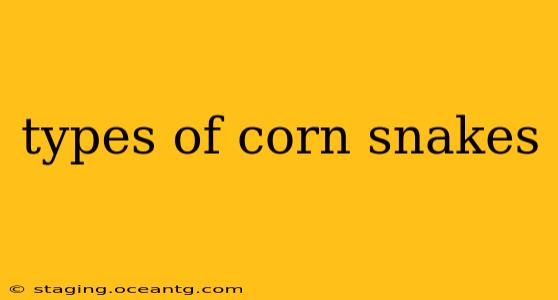Corn snakes ( Pantherophis guttatus) are beloved by reptile enthusiasts worldwide for their docile nature, relatively easy care, and stunning array of colors and patterns. Far from being a single species, corn snakes boast an incredible diversity of morphs, resulting from selective breeding over decades. This guide explores the fascinating world of corn snake morphs, answering common questions and providing valuable insights for both novice and experienced keepers.
What are the Different Colors and Patterns of Corn Snakes?
Corn snakes exhibit a remarkable range of colors and patterns, largely thanks to the dedicated efforts of breeders. While the wild-type corn snake displays a characteristic reddish-brown body with darker saddle markings, captive breeding has resulted in an explosion of morphs, showcasing variations in color intensity, pattern disruption, and even the presence of entirely new colors. These variations are often categorized into different morph groups, sometimes with overlapping characteristics.
What are the Most Popular Corn Snake Morphs?
Some corn snake morphs are exceptionally popular due to their striking appearance and relative ease of breeding. These include:
-
Amel: Amel corn snakes are known for their stunning, bright orange or reddish-orange coloration, often lacking the typical darker saddle markings of the wild type. They are a foundational morph for many others.
-
Snow: Snow corn snakes are characterized by their almost entirely white or cream-colored bodies, often with subtle hints of pastel tones. They result from combining several recessive genes.
-
Lavender: Lavender corn snakes possess a unique lilac or lavender hue, creating a captivating and ethereal look. They are often bred with other morphs to enhance their color palette.
-
Okeetee: Okeetee corn snakes are known for their striking pattern disruption – a reduction or absence of the characteristic saddle markings. They display a more uniform coloration, often in rich reds, browns, or oranges.
How Many Corn Snake Morphs Are There?
The exact number of corn snake morphs is difficult to pinpoint definitively. Breeders are constantly developing new variations through careful selection and crossbreeding. Hundreds of different corn snake morphs exist, and new ones are frequently being registered with reptile organizations. Each morph is often identified by a unique name and code within the reptile community.
What is the Rarest Corn Snake Morph?
Pinpointing the single rarest corn snake morph is challenging because rarity can fluctuate based on breeding popularity and availability. However, certain combinations of genes that result in highly unique color and pattern variations can be considered exceptionally rare within the community. These often command higher prices due to their limited availability.
Are Certain Corn Snake Morphs More Expensive Than Others?
Yes, the price of a corn snake can vary significantly depending on the morph. Rare or complex morphs resulting from multiple gene combinations are generally more expensive than common morphs. The demand for specific colorations or patterns also impacts pricing. The breeder's reputation and the health of the snake also play a role.
How to Choose a Corn Snake Morph
Selecting a corn snake morph comes down to personal preference. Consider the following:
- Appearance: Do you prefer vibrant colors, subtle patterns, or a unique combination of traits?
- Care Requirements: While corn snake care is generally similar across morphs, some may have slightly different needs depending on their genetic makeup.
- Price: Set a budget before you start looking to avoid impulse purchases.
- Breeder Reputation: Choose a reputable breeder who prioritizes the health and well-being of their snakes.
The world of corn snake morphs is vast and continually evolving. With careful research and consideration, you can find the perfect corn snake to welcome into your home and enjoy its beauty and unique personality for years to come. Remember to always prioritize responsible ownership and ethical sourcing from reputable breeders.
